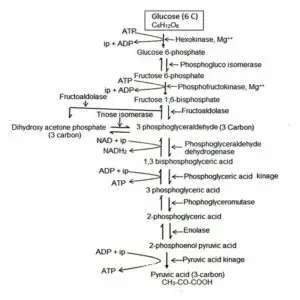Glycolysis is the metabolic pathway where one molecule of glucose (C6H12O6) converts into pyruvic acid with the help of enzyme. Glycolysis occurs in the cytoplasm of the cell during both anaerobic and aerobic respiration. It is also known as EMP pathway i.e., Embden-Meyerhof-Parnas pathway named after German Biochemists Gustav Embden, Otto Meyerhof, and Jakub Karol Parnas who first discovered the process of glycolysis in 1918. Glycolysis is also called Entner–Doudoroff pathway.
Features of Glyclysis
- Glycolysis happens in the cytoplasm;
- Glycolysis does not need or consume oxygen;
- A 6-carbon glucose is converted into 3-carbon pyruvate or pyruvic acid;
- In this case, 2 molecules of ATP are consumed to initiate the process.
- Four molecules of ATP and 2 molecules of NADH are produced after the end of the process.
Step of Glycolysis
Reaction of glycolysis include the following three main steps:
- Phosphorylation of glucose or Preparatory Phase
- Cleavage of Fructose-1, 6-diphosphate
- Formation of 3-carbon pyruvate or pyruvic acid
Step-1: Phosphorylation of Glucose or Preparatory Phase
1. At the first step, glucose undergoes phosphorylation by ATP(Adenosine triphosphate) in presence of Mg++ to form glucose-6-phosphate in the presence of hexokinase enzyme.

2. By the process of isomerization Glucose 6-phosphate is isomerized into fructose 6-phosphate with the help of phosphogluco isomerase enzyme.

3. Fructose 6-phosphate undergoes phosphorylation with the help of ATP and enzyme phosphofructokinase to form Fructose 1, 6-bisphosphate and ADP (Adenosine diphosphate).

Step-2: Cleavage of Fructose-1, 6-bisphosphate
4. Fructose 1,6-bisphosphate is broken down to two triose (3 carbon molecule) phosphate such as dihydroxyacetone phosphate and 3 phosphoglyceraldehyde with the help of the enzyme aldolase. The dihydroxyacetone phosphate is converted to 3 phosphoglyceraldehyde with the help of enzyme triose phosphate isomerase. In this case, reaction is reversible. Here two molecules of 3-phosphoglyceraldehyde are formed from the cleavage of one fructose 1, 6-bisphosphate.

Step-3: Formation of 3-carbon pyruvate or pyruvic acid
5. With the help of NAD (nicotinamide adenine dinucleotide), H3PO4 (phosphoric acid) and the enzyme phosphoglyceraldehyde dehydrogenase, 3 phosphoglyceraldehyde is oxidized to 1, 3-bishosphoglyceric acid and NADH2.


Steps of Glycolysis
6. In this step 1, 3 bishosphoglyceric acid transfers phosphoric acid to ADP with the formation of 3 phosphoglyceric acid and ATP with the help of enzyme phosphoglyceric acid kinase.

7. In the next step, 3 phosphoglyceric acid is converted to 2 phosphoglyceric acid with the help of enzyme phosphoglyceromutase.

8. 2 phosphoglyceric acid is then converted to form 2 phosphoenol pyruvic acid with the help of enzyme enolase which gives out one molecule of water.

9. It is the last step of glycolysis where 2 phosphoenol pyruvic acid is converted to form pyruvic acid by the removal of phosphorus thus one molecule of ATP is synthesized from ADP. The enzyme catalyzing this step is pyruvic acid kinase.

So in the overall process, two molecules of pyruvic acid is formed from each molecule of glucose. In animals including human being, glycogen is present in the muscle and liver cells, are phosphorylated by the glycogen phosphorylase enzyme in presence of inorganic phosphate into glucose 1 phosphate. Similarly starch of plant cells is converted to glucose 1-phosphate by the starch phosphorylase. Glucose 1-phospahte is then converted to glucose 6-phosphate with the help of enzyme phosphoglucomutase. Glucose 6-phosphate is then oxidized through the glycolytic path.
Reaction:

Thus, when one molecule of glucose (6C) undergoes the reactions in glycolysis, the overall process may be represented as follows:

In this case, 2 molecules of ATP are used up in the phase of glycolysis.
Therefore the net gains of glycolysis are:

You may also read: Fermentation Vs Respiration
Significance of Glycolysis
- This process leads to the formation of 2 molecules of pyruvic acid which is essential for running the Krebs cycle.
- During the course of formation of 2 molecules of pyruvic acid from a hexose 4 ATP molecules are produced as a result of substrate phosphorylation per molecule of hexose utilized. Now 2 ATP molecules are used up in the formation of hexose phosphate, so the phosphate energy of 2 other ATP molecules are used up in other general cellular purpose.
- Dehydoxy acetone phosphate is formed as a byproduct in glycolysis which helps in the formation of glycerol which ultimately leads to fat metabolism.
- The different intermediary products are produced in glycolysis which can be used by the plants in different metabolic functions of the body.
